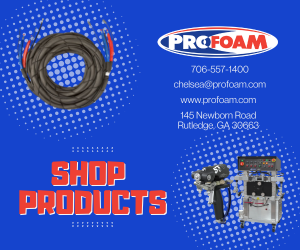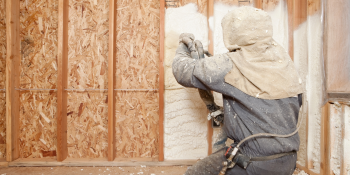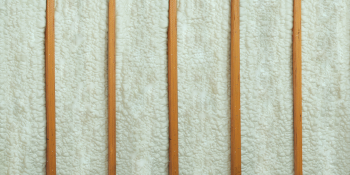Q&A Forums
Waste and Spraying Methods Post New Topic | Post Reply
| Author | Comments |
|---|---|
|
Trey Gibson
Posted: Mar 07, 2006 08:11 AM
|
Waste and Spraying Methods
Just wondering how you guys spray .5 lb foam. With a flat tip attachment or round? If you use a flat tip do you fill the entire cavity in one pass or you doing two passes per cavity, meaning one pass on the left side then one on the right, or vice versa? Also, how many bags of waste is considered good or acceptable for lets say a 4,000 sq ft house?
|
|
Timothy Sonney
Posted: Mar 08, 2006 12:45 AM
|
ZERO waste is the goal. Us, we don't have any wasted/throw away product. The bags, big chunks, etc of extra foam that we end up with I sell to my neighbor for a few bucks a bag - he just dumps it in his attic. This gets collected as Petty Cash. |
|
Trey Gibson
Posted: Mar 08, 2006 09:35 AM
|
So how are you filling the cavities and ending up with no waste? Do you put in a nominal 3.5" or do you use rigid? and in that case I understand why there is no waste. |
|
Posted: Mar 12, 2006 03:05 AM
|
i see many applicators specifying 2" nominal in a 2x4 or 4" nominal in a 2x6.... i also recieve numerous calls from concerned customers and general contractors because the "person spraying their home" is assuring them that this is OK..."all the foam they need" well,,, R3.8 x 2 inches = 7.6 R3.8 x 4 inches = 15.2 (this assumes you are applying a r3.8/inch foam,,many are r3.5/inch) look at the k values for the open cell foams,,,it aint closed cell,,,and yes it does a great job sealing by nature of its expansive application..but it is air/vapor permiable...and,,,i just aint sure that R7.6/R15 is enough for the shacks i am spraying...and if it is "OK" cause foam stops the air movement,,then Rvalue is Rvalue,,and the 40-50% energy saveings can not be obtained with these lessor Rvalues...more comfortable (less drafts) quieter home,,,maybe,,,but increased thermal performance,,,not... so to keep on topic,,,i haul alot of open cell foam waste out of a 4000 sq ft shack....to assure i have done my job well,,and to assure customer satisfaction... i tend to try to top the cavities to give the customer the Rvalue spec'd for the wall cavity... that is R11/13 2x4 (3.8 x 3=11.4,,,3.8x5=R19).. yep i trim alot and have a buttload of waste...but i am not going to underapply,,, Rvalue is Rvalue...Uvalue is Uvalue... design specs are design specs,,, fill the cavity (+/- 1") and trim it...good perfoamance and good r value= happy customers and many good referals.... |
|
Posted: Mar 12, 2006 08:44 PM
|
Just my 2cents. In our 31 yrs. of buisness I have seen some pretty aggresive marketing strategies brought to this industry by the open cell manufactures. Some claims accurate , some not. I do believe that open cell does deserve some market share. However you can't convince me that it holds a candle in the wind to closed cell. Sorry open cell guys but real world experience doesn't lie. I do agree it's much better than fiberglass, but doesn't offer all the benefits of closed cell. In exterior wall applications save your garbage bags, closed is the way to go. A little stud scraping and off to the next one. If any one can give me one example of closed cell being superior in exterior application I'd love to hear it. Again just my 2 cents. |
|
Posted: Mar 12, 2006 08:55 PM
|
|
|
Trey Gibson
Posted: Mar 12, 2006 09:17 PM
|
As far as ease of application there is no doubt closed cell is better. But when it comes to soundproofing, open cell is the way to go. Being in Texas where the environment is humid they tell us to be weary when putting closed cell in exterior walls, I don't necessarily agree but everybody has there own theories when and where the different weights of foam should be installed. |
|
Posted: Mar 14, 2006 06:09 PM
|
Foamer1 There is no dought an open cell provides better sound obsorption, in an interior residential wall applications. As for exterior wall applications closed cell is always better. Almost all cases of moisture problems in exterior walls are linked to air laden moisture. Which will be stopped by the spf.Vapor diffusion is almost never a problem in wall cavities unless drainage plane issues are evident. In which the insulation should not be blamed. We have been clearing the muddy waters caused by the fiber insulation manufactures for 30 yrs.We need to stay together to grow the spf industry whether we spray open or closed cell,and therefore we can not be misled by clever advertising we need to research the building sciences ourselves so that we can be educated applicators. |
|
Posted: Mar 14, 2006 07:40 PM
|
we should consider having the moderator moving this to a new topic heading,,it is a good and important one,,,waste,,it is not..hee hee "Being in Texas where the environment is humid they tell us to be weary when putting closed cell in exterior walls" i ran a 2x6 wall with ext air film,vinyl sideing, osb,3" urethane closed cell, gypsum, paint, int air film useing weather data for dallas/ft worth...(H.A.M software)...ran summer data 100 ext with 85% relative humidity (you said it was humid)interior at 70 degrees and 50%RH...and it showed no condensation in the wall cavity.... R-20,,,no vapor barrier used in above "wall mockup"... so why should it be avoided? dont believe everything you hear,,,question whether the advice being tendered is based on science, and good ethical business practice,,,or if the opinion is self fullfilling... "we need to research the building sciences ourselves so that we can be educated applicators" ABSOLUTELY,,,we are "messing" with peoples homes here ,,,some worth millions...our product application has to be based on sound building science,,not on sales/training literature...(see above paragraph)...there is a wealth of information available to all if we take the time to read,,,study,,,re-read.,.study some more,,,ask those who know,,,ask those who dont...ask some more...and keep your eyes wide open all the time... first robin yesterday in the cornfields... bring on spring.... |
|
Trey Gibson
Posted: Mar 14, 2006 07:56 PM
|
By drainage plane issues do you mean lack of or faulty installation of a vapor barrier such as a housewrap? |
|
Posted: Mar 15, 2006 01:53 PM
|
Foamdude Amen! another informed applicator. I feel that we as foam applicators hold a responsibility to the the consumer to be educated in the building sciences. The best product in the world can't stand up if improperly applied. Foamer1 By drainage plane we are talking about the ability to allow rain a means to escape the structure without being able to enter the building. Drainage planes most often fail as flashings around windows and doors. With drainage planes we are emphasizing liquid water not so much vapor diffusion. For some good reading go to building science corp. Come on Spring. |
|
Trey Gibson
Posted: Mar 15, 2006 08:41 PM
|
I appreciate all the information as this is an industry that requires continued education. I believe an open forum such as this is great and as more people join and participate we can all better our businesses. |
|
Posted: Mar 16, 2006 05:55 AM
|
"By drainage plane issues do you mean lack of or faulty installation of a vapor barrier such as a housewrap?" well designed structures are design & built to allow water (gross or vapor) to "drain" from the structure to allow the structure to dry back to a "normal" state... HOUSEWRAP IS NEVER A VAPOR BARRIER...it is applied as a feeble attempt at an AIR BARRIER...(some builders say it is a drainage plane,,boohunky!)...imagine this..lets put up housewrap and now lets fasten it to the structure with about 10,000 staples...electrical box here,,winder opening there,,,here a perforation,,there a perforation...air barrier my butt...(foam good!!!) you need to understand water vapor and its transport,,,YOU NEED TO UNDERSTAND JUST WHAT IS AND WHAT ISNT(materials, includeing foam!) A VAPOR BARRIER..you need to know where a vapor barrier is applied in you area,,,if at all...(this is an issue with many builders,,,some do, some dont, some will, some wont) realize the the MOISTURE adhesive spray applied shredded paper insulation people...opps i mean cellulose people now say NO VAPOR BARRIER,,duh,,,they want the moisture THEY INTRODUCE INTO THE WALL CAVITY TO DRY,,,(future liability me thinks),eventulaly,,they dont give a ratsass that the structure here in the cornfield will be subjected to 200+ grains of condensation per SQUARE FOOT per day on the OSB sheeting when it is -10 degrees here and the home is heated and occupied as normal,,frost on the osb me thinks..frost + warm temps= melting= water in the paperinsulation cavity = MUSH ...nice..(guess they can put it on the lawn for a seeding mulch!) didjaknow that mold start to grow with as little as a 21% RH in a wall,, and that it can then thrive (sustained & propagate) with as little as 15% RH,,, time to go take on the day... have a great one!! |
|
Posted: Mar 21, 2006 07:41 PM
|
Foamdude- I totally agree with you the house wraps are not vapor barriers. They do however offer some protection to osb or ply wood from water that leaks behind the siding. The building industry is cause for much of its own problems. An interesting bit of information that I learned a while back was that although the majority of houses are built utilizing vinyl siding. Siding was only ever meant as a means of cleaning up a building , or should I say reside. It was never designed to be used as we have all know it today in new construction. House wraps are the easiest cheapest way to offer some protection to the sheathing. Builders do not know what else to use since saturated felt is not recommended behind vinyl, and most use the cheapest siding they can find to protect a home.I see a pattern Lets look at a typical house construction osb-cheap,house wrap-cheap,fiberglass-cheap. Tell me again why we see problems with new homes. Well thats for another forum. Sorry I got off track. |




























